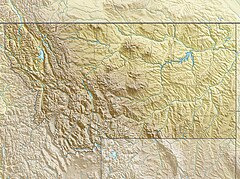| Gardner River | |
|---|---|
 Gardner River near its confluence with the Yellowstone River | |
| Location | |
| Country | United States |
| States | Wyoming, Montana |
| Physical characteristics | |
| Source | |
| • location | Joseph Peak, Yellowstone National Park, Wyoming |
| • coordinates | 44°57′15″N 110°52′03″W / 44.95417°N 110.86750°W[1] |
| Mouth | Yellowstone River |
• location | Gardiner, Montana |
• coordinates | 45°01′47″N 110°42′01″W / 45.02972°N 110.70028°W[1] |
| Length | 25 mi (40 km) |
| Basin size | 202 sq mi (520 km2)[2] |
| Discharge | |
| • location | near Mammoth |
| • average | 213 cu ft/s (6.0 m3/s)[3] |
| Basin features | |
| Tributaries | |
| • left | Lava Creek, Obsidian Creek |
| • right | Glen Creek, Indian Creek (Wyoming) |
The Gardner River (also known as the Gardiner River) is a tributary of the Yellowstone River, approximately 25 miles (40 km) long,[1] in northwestern Wyoming and south central Montana in the United States. The entire river is located within Yellowstone National Park. It rises on the slope of Joseph Peak, Gallatin Range in the northwestern part of the park, and winds southeast through Gardner's Hole, a broad subalpine basin which is a popular trout fishing location. The Gardner falls within the Native Trout Conservation Area and anglers are allowed to take an unlimited number of brown and rainbow trout. Mountain whitefish and Yellowstone cutthroat trout must be released. Angling on the Gardner is governed by Yellowstone National Park fishing regulations.[4] After merging with Panther Creek, Indian Creek and Obsidian Creek, it then turns north and flows through a steep canyon where it cuts through a basaltic flow from approximately 500,000 years ago known as Sheepeater Cliffs. Below Sheepeater, Glen Creek out of Golden Gate Canyon and Lava Creek out of Lava Creek Canyon join the Gardner near Mammoth Hot Springs. The river crosses the 45th parallel in Gardner Canyon and is also home to a popular hot spring known as The Boiling River.[5] The river continues north through Gardner Canyon and empties into the Yellowstone near Gardiner, Montana.
- ^ a b c U.S. Geological Survey Geographic Names Information System: Gardner River, USGS GNIS
- ^ "USGS 06191000 Gardner River near Mammoth YNP". Retrieved 2012-06-20.
- ^ "USGS Surface Water data for Montana: USGS Surface-Water Annual Statistics".
- ^ 2020 Yellowstone National Park Fishing Regulations
- ^ "Mammoth Hot Springs Highlights". National Park Service. Archived from the original on 2012-06-18. Retrieved 2012-06-21.

